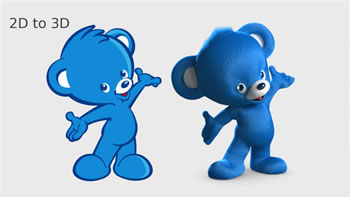Difference between 2D, 3D and 4D
Key difference: The terms 2D, 3D, and 4D stand for two-dimensional, three-dimensional and four-dimensional respectively. They are named for the number of dimensions that they portray. 2D represents an object in just two dimensions, while 3D represents it in three dimensions. The fourth dimension however is an abstract concept.
 A dimension is ‘any measurable spatial extent, such as length, breadth, height, depth, width, thickness, etc.’ The terms 2D, 3D, and 4D stand for two-dimensional, three-dimensional and four-dimensional respectively. They are named for the number of dimensions that they portray. 2D represents an object in just two dimensions, while 3D represents it in three dimensions.
A dimension is ‘any measurable spatial extent, such as length, breadth, height, depth, width, thickness, etc.’ The terms 2D, 3D, and 4D stand for two-dimensional, three-dimensional and four-dimensional respectively. They are named for the number of dimensions that they portray. 2D represents an object in just two dimensions, while 3D represents it in three dimensions.
It is best to think of it with an example. A car has three dimensions. In fact, everything in our reality is three-dimensional. It has length, width, and height; however a photograph of a car or a drawing of a car has only two dimensions. In the photo or drawing, one can only see and measure length and height, whereas the depth or width is indistinguishable.
 The fourth dimension however is an abstract concept. The world we live in is essentially three dimensional, which means that everything has a length, width (depth), and height, nothing more and nothing less. The fourth dimension is derived by generalizing the rules of three-dimensional space. 4D adds the factor of time and motion to 3D. Essentially, a 3D object that moves is considered to be four dimensional. The concept of 4D is very difficult to grasp as it’s not actually something that can be actually visually understood, mainly because it does not actually exist in the real world.
The fourth dimension however is an abstract concept. The world we live in is essentially three dimensional, which means that everything has a length, width (depth), and height, nothing more and nothing less. The fourth dimension is derived by generalizing the rules of three-dimensional space. 4D adds the factor of time and motion to 3D. Essentially, a 3D object that moves is considered to be four dimensional. The concept of 4D is very difficult to grasp as it’s not actually something that can be actually visually understood, mainly because it does not actually exist in the real world.
In relational to movies, there are the regular films, the 3D films and then there are 4D films. Here the regular films are 2D as they are flat, representing only two dimensions, the height and width. Whereas, 3D movies layer two different images to create the illusion of a three-dimensional image. 4D films, however, are screened in special theaters, that show 3D movies but with added special effects that take place in the theater itself. These often include vibrating seats, water jet sprays, air sprays, and even a variety of smell at times. These effects add to the viewing experience and enhances. While, this has nothing to do to with the actual 4D concept, the term 4D films have become a marketing gimmick.
Comparison between 2D, 3D and 4D:
|
|
2D |
3D |
4D |
|
Full Form |
Two-Dimensional |
Three-Dimensional |
Four- Dimensional |
|
Definition |
Represents an object with just two dimensions, i.e. length, and height. |
Represents an object with three dimensions: Length, width, and height |
Represents an object with four dimensions: Length, width, height, and time/motion. |
|
Representation |
Flat |
Life-like |
Abstract concept |
|
Aspects |
Length, and height, no depth (width). |
Length, width, and height |
Length, width, height, and time/motion. |
|
Mathematics |
The x-axis and y-axis. |
The x-axis, y-axis and the z-axis. |
Generated by applying the rules of vectors and coordinate geometry to a space with four dimensions, in particular a vector with four elements (a 4-tuple). |
|
Geometry |
Rectangle, square, triangle, polygon, etc. |
Cylinder, sphere, cube, pyramid, prism, etc. |
Polychora (4-polytopes) made of polyhedra (made of two dimensional polygons). |
|
Movies |
Regular films |
3D Films that use optical illusion to create the representation of a three-dimensional film. |
A 3D film with the added effects that take place in specially designed theaters. |
Image Courtesy: ogilvyentertainmentblog.com, wikipedia.org









Comments
bhudhalal
Fri, 06/30/2017 - 10:22
Tim Morrell
Fri, 05/12/2017 - 07:21
Add new comment